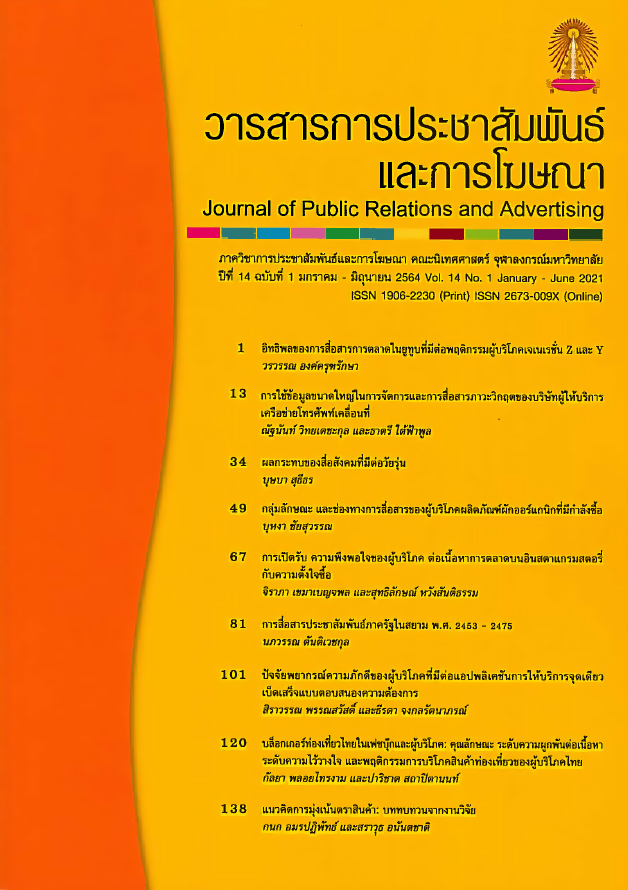Consumers’ Exposure, Satisfaction and Purchase Intention Towards Content Marketing on Instagram Stories
Main Article Content
Abstract
The purpose of this research is to study consumer exposure and satisfaction towards content marketing on Instagram stories as well as to explain the relationship between consumer satisfaction towards content marketing on Instagram stories and purchase intention. The quantitative research was conducted via online questionnaires to collect data from 400 respondents. The results of this research show that: 1) Consumer exposure towards content marketing on Instagram stories overall was moderate. 2) Consumer satisfaction towards content marketing on Instagram stories overall was moderate. 3) Consumer purchase intention was high on clothing and food items after watching content marketing on Instagram stories, but moderate on electronic and furniture times as well as hotel booking. The Hypothesis testing results show that: 1) Sex, age, status and income have impacts on consumer exposure towards content marketing on Instagram stories. 2) Consumers of different sex, age have different levels of satisfaction towards content marketing on Instagram stories. 3) Consumers of different age and income have different levels of satisfaction towards content marketing on Instagram stories. 4) Consumer satisfaction towards marketing content on Instagram story strategy has correlation with purchase intention after viewing of marketing content on Instagram story. The correlation was positive but at a low level.
Article Details
References
โชติรัตน์ ศรีสุข. (2554). กลยุทธ์การสื่อสาร และการรับรู้รูปแบบโครงการความรับผิดชอบต่อสังคมของบริษัท ไทยเบฟเวอเรจ จำกัด (มหาชน). วิทยานิพนธ์ปริญญาบริหารธุรกิจมหาบัณฑิต. สาขาวิชาการประกอบการ บัณฑิตวิทยาลัย มหาวิทยาลัยศิลปากร.
โชติหทัย นพวงศ์. (2542). การติดตามข่าวสารกับความพึงพอใจในการสื่อสารและการทำงานของพนักงานเครือซิเมนต์ไทยในช่วงการปรับโครงสร้างธุรกิจ. (วิทยานิพนธ์ปริญญามหาบัณฑิต). จุฬาลงกรณ์มหาวิทยาลัย, คณะนิเทศศาสตร์.
ณภัคอร ปุณยภาภัสสร. (2551). ปัจจัยที่มีอิทธิพลต่อการตัดสินใจซื้อประกัน. วารสารวิทยาลัยพาณิชยศาสตร์บูรพาปริทัศน์, 8(1). 93-104.
ดวงฤทัย พงศ์ไพฑูรย์.(2554). การเปิดรับข่าวสาร ความรู้ และทัศนคติเกี่ยวกับเพศศึกษาของวัยรุ่นในเขตกรุงเทพมหานคร, กรุงเทพมหานคร: จุฬาลงกรณ์มหาวิทยาลัย.
ปราการ กองแก้ว. (2556). การเปรียบเทียบความพึงพอใจของผู้บริโภค ที่มีต่อปัจจัยส่วนประสมทางการตลาดของผู้ผลิตสุขภัณฑ์รายใหญ่ กรณีศึกษาเฉพาะในเขตกรุงเทพมหานคร . มหาวิทยาลัยสุโขทัยธรรมาธิราช. นนทบุรี.
ศิวัช จันทนาสุภาภรณ์. (2554). พฤติกรรมการเปิดรับสื่อ. ภาควิชาเอกระบบสารสนเทศคณะบริหารธุรกิจ มหาวิทยาลัยเทคโนโลยีราชมงคลธัญบุรี
Netrix. (2014). “Content Marketing คืออะไร?”. วันที่เข้าถึงข้อมูล 6 มีนาคม 2563. แหล่งที่มา www.nextrix.com/blog/
Ourgreenfish. (2018). CONTENT MARKETING มีความสำคัญอย่างไรในการทำ DIGITAL. วันที่เข้าถึงข้อมูล 6 มีนาคม 2563. แหล่งที่มา https://blog.ourgreenfish.com/th/how_content_marketing_important
Shifu Team. (2019). “จับตาเทรนด์ E-Commerce ไทย ปี 2020 ทำอย่างไรให้ธุรกิจอยู่รอดในยุคไร้พรมแดน.”, วันที่เข้าถึงข้อมูล 6 มีนาคม 2563. แหล่งที่มา https://contentshifu.com/ecommerce-trends-priceza/
Blumler, Jay G. (1985). “The Social Characters of Media Gratifications,” in Rosengren Karl Erick, Wenner Lawrence and Philip Palmgreen Media Gratifications Research: Current Perspectives. Beverly Hill, CA.: Sage.
Josh Constine. (2019). “Facebook plans new products as Instagram Stories hits 500M users/day.”, Retrieved January 14, 2020, from https://techcrunch.com/2019/01/30/instagram-stories-500-million/
Kantar Millward Brown. (2017). AdReaction: Engaging Gen X, Y and Z. Retrieved from https://www.millwardbrown.com/adreaction/genxyz/
Katz, E., Blumler, J. G., & Gurenitch, M. (1974). Uses and gratifications research. Public Opinion Quarterly, 37(4), 509–523.
Kotler, Philip. (2003). Marketing Management. 11th ed .Upper Saddle River, NJ: Prentice.
Maryam Mohsin. (2019). “10 Instagram Stats Every Marketer Should Know in 2020 [Infographic].”, Retrieved January 14, 2020, from https://www.oberlo.com/blog/instagram-stats-every-marketer-should-know
Petty, R. E. and Cacioppo, J. T. (1986). The Elaboration Likelihood Model of Persuasion. Advances in Experimental Social Psychology, 19(C), 123-205.
Simon Kemp. (2020). “Digital 2020 Global Overview Report.”, Retrieved February 19, 2020, from https://wearesocial.com/blog/2020/01/digital-2020-3-8-billion-people-use-social-media
Simon Kemp. (2020). “DIGITAL 2020: THAILAND.”, Retrieved February 19, 2020, from https://datareportal.com/reports/digital-2020-thailand


